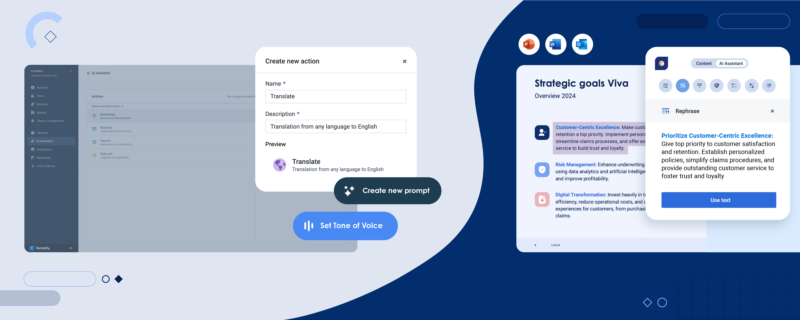These days, you can access a business document virtually anywhere. Why not boost productivity and save time by giving your team the opportunity to create and manage content on the go?
In today’s digital age, tools and tech have completely revolutionized the way we work with documents and content. With each new development, the most innovative companies have seen their productivity skyrocket by scaling up from manual or outdated tools to digital platforms and automated processes.
Today, Microsoft Office Suite helps us create a range of content with a few simple clicks, document templates and pre-prepared presentation decks ensure that we don’t needlessly create the same documents from scratch, and content management systems help us automate the document creation process to eliminate productivity roadblocks and save time.
Meanwhile, an exploding category of devices such as smartphones and tablets mean that we can easily access our business documents and content at any time.But there’s another reason these tools and applications have helped us be more productive: not only have they changed how we work with documents and sped up our business processes - they’ve also changed where we work with them.
Mobile productivity: it's about the journey, not the destination
Think of business trips, journeys by bus or train, long stretches of time in a waiting room or the gaps between meetings – in other words, “time sinks” that can feel frustrating when you know there’s a pressing business task at hand. Yet with the tools we have available, these time sinks could actually become opportunities to work on a major presentation or project.
By decoupling work from a physical location via tools and empowering your team members to be productive and creative no matter where they are, they can tap into that work document and get ahead on a task on their own terms, even on the go. In other words, working on the go means your team will be working smarter, rather than harder.
When you offer this kind of flexibility, you’re bound to attract creative up-and-comers to your organization and keep your current employees happy - both critical features of highly-productive teams.
But how can you foster a culture of working-on-the-go among your team members? Here are two key points to keep in mind:
It’s about the right tools
One of the biggest challenges involved in working away from your office space is that sometimes you’ll end up needlessly creating a completely new document from scratch - when the information is already pre-filled in a template at your office.
Even if you can open up a word processor on your tablet, you might need to be physically in-office, and at your work computer, to access all the necessary documents, email signatures and templates that make work go faster on a routine workday. Or you might only have copies of old files or templates stored in your inbox or saved to your device, meaning you risk working to a document that is not on-brand or compliant.
Investing in tools and software which can integrate across devices is key here. For example, an email signature management tool allows head office to monitor that your email signature is up-to-date and pre-filled with necessary information about relevant promotions, so that you as an individual don’t have to think about it when traveling.
Meanwhile, document management software ensures that you can access the most up-to-date company content and templates at any time. For example, Templafy allows you to create on-brand, compliant files wherever you are - alerting the user via the app if there’s a problem. And because it integrates easily with all office platforms and across multiple devices, you can dig up a template at any time, whether you’re at your office desktop or working remotely from your tablet while on a business trip.
The office is increasingly mobile
Harnessing the benefits of remote working isn’t just about encouraging your employees to work from home. It’s about promoting the idea that they can work just about anywhere and save time.
Of course, working on the go is about more than just having the right tools. We also need our environment to match up with the remote revolution - by offering features such as accessible plug outlets for laptops and tablets, and high-speed wifi access. Fortunately, it seems the public space is catching on to the fact that people increasingly operate in a “mobile office” and want to be able to access their documents on the go wherever they are.
Take France, for example. After rolling out wifi across dozens of railway stations across the country, last year French national rail operator SNCF installed high-speed wireless WI-Fi on its high-speed Lyon-Paris route. With the help of a new technology, it’s the first time a broadband network will be fitted to a train reaching speeds of up to 300 km/ph - showing just how innovatively our physical environment is responding to the needs of an increasingly mobile workforce. Now, even a train hurtling towards Paris can function as your mobile office, allowing you to access your work documents remotely and power through a task on the journey.
Planes are another example. Once, boarding a plane meant completely tapping out, even if you’re traveling to an important meeting or conference and need to perfect that presentation or document. Now, the needs of business travellers mean flights are increasingly offering connectivity to passengers at 35, 000 feet, meaning that you can work on nailing your content while in the air.
Bottom line: the world around us is increasingly responding to the needs of the mobile workforce, so encourage your employees to harness opportunities to use a public space as an office space - that is, if they can tear themselves away from the views of the French countryside.




